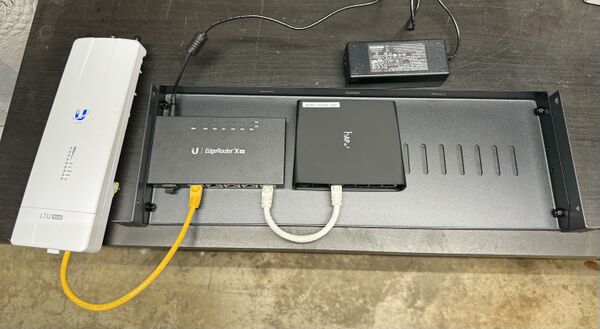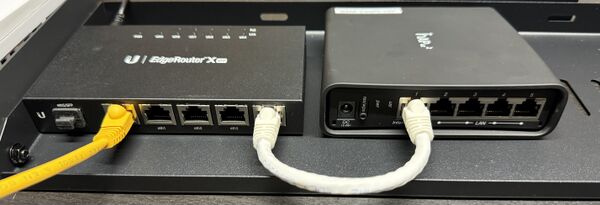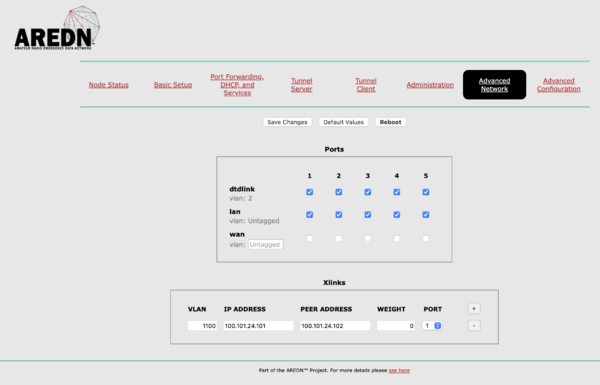Backbone Site Hardware: Difference between revisions
Jump to navigation
Jump to search
No edit summary |
No edit summary |
||
| Line 25: | Line 25: | ||
Both the hAP and the Router require custom configuration. |
Both the hAP and the Router require custom configuration. |
||
| − | === hAP |
+ | === hAP ac<sup>2</sup> Configuration === |
| + | [[File:TypicalHardwareAdvNetwork.png|none|thumb|600x600px]] |
||
| − | ... |
||
| + | The hAP is configured just like any other AREDN nodes; but there are a few changes in the ''Advanced Network'' tab. |
||
| + | |||
| + | ==== Ports ==== |
||
| + | |||
| + | * All the ports, 1 through 5, are configured as both AREDN LAN and AREDN DtD ports. This gives us a lot of flexibility in what devices we can attached to the node later. |
||
| + | * We have no WAN ports selected as we dont use any local Internet services at sites. |
||
| + | * Port 1 is the PoE-IN port. This configuration lets us power the hAP with PoE. |
||
| + | |||
| + | ==== XLinks ==== |
||
| + | The basic configuration uses one xlink to connect this AREDN device to others over the airFiber radio. More information about xlinks can be found in the [https://docs.arednmesh.org/en/latest/arednHow-toGuides/xlinks.html AREDN documentation]. In this configuration: |
||
| + | |||
| + | * We use VLAN 1100. XLink data is always encapsulated with a VLAN, and for backbone traffic we use VLANs starting at 1100. |
||
| + | * Port 1 is selected - the same port providing power, DtD and everything else to the hAP from the Router. |
||
=== EdgeRouter X SFP Configuration === |
=== EdgeRouter X SFP Configuration === |
||
Revision as of 10:48, 7 November 2023
We had tried to standardize hardware at sites where we can. This simplified management and maintenance.
Hardware
The image belows illustrates the basic hardware we would install at a backbone site.
This consists of the following components:
- An Ubiquiti EdgeRouter X SFP which supports the backbone routing protocols, as well as providing power-over-ethernet to the other components
- A Mikrotik hAP ac2 which provides AREDN services at the site
- An Ubiquiti airFiber radio which connects this site to others in the network
- A 19" rack shelf to install the hardware on.
- 24v power input, either from an AC/DC converter, or from a battery backup supply (not shown here)
Connections
By using a PoE router, we simplify the wiring of the rest of the system as every other component is powered over ethernet.
- The white cable on the right provides networking and power to the hAP.
- The yellow cable on the left provides power and networking to the airFiber radio.
- Additional backbone devices can use the additional three ports on the router (with appropriate configuration - see below)
- Additional AREDN devices can use either the additional router ports or the hAP ports (with appropriate configuration - see below)
Configuration
Both the hAP and the Router require custom configuration.
hAP ac2 Configuration
The hAP is configured just like any other AREDN nodes; but there are a few changes in the Advanced Network tab.
Ports
- All the ports, 1 through 5, are configured as both AREDN LAN and AREDN DtD ports. This gives us a lot of flexibility in what devices we can attached to the node later.
- We have no WAN ports selected as we dont use any local Internet services at sites.
- Port 1 is the PoE-IN port. This configuration lets us power the hAP with PoE.
XLinks
The basic configuration uses one xlink to connect this AREDN device to others over the airFiber radio. More information about xlinks can be found in the AREDN documentation. In this configuration:
- We use VLAN 1100. XLink data is always encapsulated with a VLAN, and for backbone traffic we use VLANs starting at 1100.
- Port 1 is selected - the same port providing power, DtD and everything else to the hAP from the Router.
EdgeRouter X SFP Configuration
...


